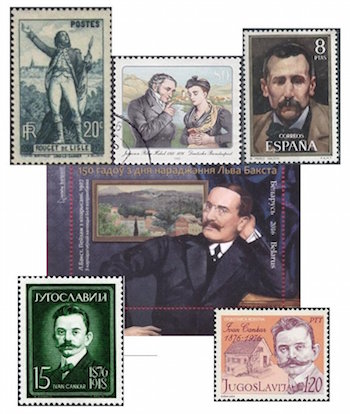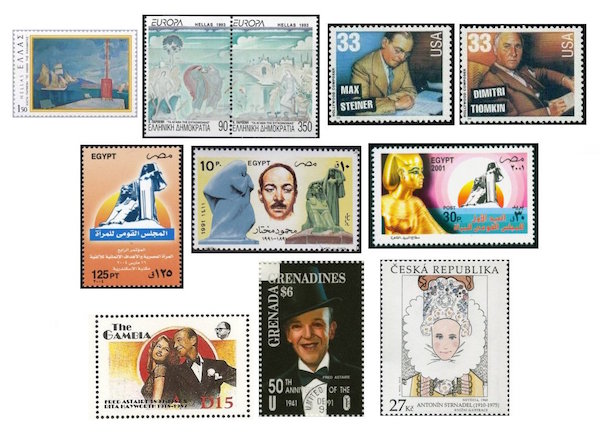The Arts on the Stamps of the World — May 10
An Arts Fuse regular feature: the arts on stamps of the world.

By Doug Briscoe
May 10th is the birthday of the composer of the Marseillaise (text and music), Claude Joseph Rouget de Lisle (1760 – 26 June 1836). A French army officer, he wrote a modest number of other songs and died in poverty.
Born on precisely the same day in a city not so far away (Basel) was the German writer Johann Peter Hebel (10 May 1760 – 22 September 1826). His interests were botany, natural history, and theology, and he worked as a teacher before writing his Allemannische Gedichte, poems composed in the Alemannic dialects of German. These were greatly admired by such giants as Goethe (who once tried his hand at writing a poem in Allemannic), Gottfried Keller, Tolstoy, and Hermann Hesse. One of Hebel’s poems, A New Year’s Song, was set to music as an a cappella chorus by Mendelssohn. Hebel’s later works were biblical stories for the young.
Some readers see Benito Pérez Galdós (May 10, 1843 – January 4, 1920) as the greatest Spanish novelist after Cervantes. As with so many others, this writer began professionally in journalism, publishing critical articles on the arts and pieces on politics. An early admirer of Balzac and Dickens, he translated Pickwick Papers in 1868 and in that year that started writing his own first novel, La Fontana de Oro, published in 1870. After a slow start it was gradually recognized as a literary landmark. Soon Galdós began work on a vast project of novels the Episodios Nacionales (National Episodes), dealing with the history of Spain from 1805 to “the present”. By the time he was finished, “the present” was 1912, and there were 46 books in the series. In addition, Pérez Galdós wrote 31 other novels, 46 plays, and 20 volumes of stories, journalism, etc. For five consecutive years, 1912–16, he was nominated for the Nobel Prize, one of those suggesting his name being the 1904 winner José Echegaray. In later years when he encountered financial difficulties the king and prime minister were among the first supporters of a subscription plan, but that was firmly opposed by the Catholic press, which resented the anticlericalism of much of his writing. When the program was finally aborted in 1916, the government supplied him with a monthly stipend for work he was never required to complete. Luis Buñuel made no fewer than three films based on Pérez Galdós’s work, Nazarín (1959) Viridiana (1961), and Tristana (1970). On the stamp, we see a detail from the 1894 Portrait of Galdós by Joaquín Sorolla.
There is some confusion, to understate the case, regarding the birthdate of Russian-Jewish painter Léon Bakst. English Wikipedia agrees with Russian and Japanese that the proper date is 8 February (27 January O.S.), while Portuguese says 28 April, German claims May 9th, and the Romance language pages, along with Korean, opt for today’s date, 10 May. Other sources find I none, and since the other dates have all expired, let’s go with the 10th! The year, in any event, was 1866. His circumstances were comfortable, his father being a tailor favored by the Tsar. Young Leyb (he was born Leyb-Khaim Izrailevich Rosenberg) expressed interest in becoming a painter, against the wishes of his parents, and attended classes at the St. Petersburg Academy of Arts as an observer only, since he had failed the entry exam. He was, however, eventually admitted to the Imperial Academy in 1883 and gave his first exhibition six years later, at which time he took the name “Lev Nikolaevich Bakst” because it sounded “less Jewish”. His work for the stage began in 1908, when he painted backdrops for the Ballets Russes of Sergei Diaghilev. Among his later work was the set design for Scheherazade (1910), Le Spectre de la Rose (1911), L’après-midi d’un faune (1912), and Daphnis et Chloé (1912). He died on the 27th of December (or the 28th, even that is hard to nail down) in 1924. The minisheet from Belarus was issued just last year for the 150th anniversary of his birth year.

Ivan Cankar (TSAHN-kar; 10 May 1876 – 11 December 1918), a vigorous defender of Slovene ethnicity, is viewed as that language’s greatest writer. He was born near Ljubljana and lived much of his young adulthood in Vienna. He began as a poet, became politically involved, wrote socially engaged novels and plays, opposed the creation of a Yugoslavian state, was briefly incarcerated a couple of times by the Austro-Hungarian government, and died at the age of 42 during the Spanish flu epidemic. Much concerned with spirituality as well as with sociopolitical matters, Cankar was reared a Roman Catholic, became a freethinker and adopted anitclerical attitudes, absorbed the philosphical ideas of Emerson, Nietzsche, and Maeterlinck, and finally embraced a personalized orthodox Christianity. His novel Hiša Marije Pomocnice (The Ward of Mary Help of Christians) (1904) was championed by Thomas Mann, who helped get a German edition published in 1930. While Cankar’s novels have not retained their central place in the literature, his style is much admired, and the plays continue to be popular in Slovenian theater.
Greek painter Konstantinos Parthenis (10 May 1878 – 25 July 1967) was born in Alexandria. He studied at the Vienna Academy of Fine Arts (as well as at the Vienna Conservatory) and gave his first show in that city in 1899. His second exhibition was held at Athens, and for a time he painted icons and frescoes. He absorbed expressionism from the Germans and post-impressionism from the French (he lived in Paris for some years), adapting them to his personal style. The Greek stamps show his Kalamata Harbor (1911) and The Benefits of Transportation (1920-25). The latter pair is what we philatelists call a se-tenant issue, that is, two different designs conjoined.
By a remarkable coincidence, two of the most celebrated Hollywood film composers, Max Steiner (1888-1971) and Dmitri Tiomkin (1894-1979), happen to have been born on the same day, May 10. Both received many nominations for Academy Awards, and each composer won three times. Both were Jewish immigrants, Steiner from Austria and Tiomkin from Ukraine.
Steiner’s father built the Riesenrad (the giant Ferris wheel) in Vienna, his godfather was Richard Strauss, and he studied with Mahler! Among his many famous film scores are those for King Kong (1933), The Lost Patrol (1934), The Informer (1935), The Charge of the Light Brigade (1936), Dark Victory (1939), Gone with the Wind (1939), Casablanca (1942), Arsenic and Old Lace (1944), Mildred Pierce (1945), The Treasure of the Sierra Madre (1948), and Key Largo (1948).

Tiomkin’s list includes Lost Horizon (1937), Mr. Smith Goes to Washington (1939), It’s a Wonderful Life (1946), Strangers on a Train (1951), High Noon (1952), Dial M for Murder (1954), The Old Man and the Sea (1958), and Rio Bravo (1959). He also wrote the theme for the television Western Rawhide.
The Egyptian sculptor Mahmoud Mukhtar (May 10, 1891 – March 28, 1934) is best known for his Egyptian Awakening (1928), designed as an acknowledgement of the country’s past (the sphinx) and its hopes for the future (the woman lifting her hijab). It was partly inspired by the activist Huda Sha’arawi, who went unveiled in 1922 and organised demonstrations against the British mandate, which in turn led to Egyptian independence in 1923. Such is the resonance of the sculpture that it can be seen on at least three Egyptian postage stamps.
Fred Astaire (born Frederick Austerlitz; May 10, 1899 – June 22, 1987) is not yet among the stars of the silver screen recognized on American stamps, but for the time being we can enjoy a couple from Gambia (where he is paired, not with Ginger Rogers, but with Rita Hayworth) and Grenada.
Antonín Strnadel (10 May 1910 – 31 October 1975) was an Czech painter, graphic artist, and book illustrator. One of his pieces in the latter field, The Bride (1960), is shown on the stamp. He otherwise specialized in representations of Wallachian folk life. His uncle was the sculptor Jan Knebl, and his brothers Bohumír and Josef were writers.
A graduate of the University of Massachusetts with a B.A. in English, Doug Briscoe worked in Boston classical music radio, at WCRB, WGBH, and WBUR, for about 25 years, beginning in 1977. He has the curious distinction of having succeeded Robert J. Lurtsema twice, first as host of WGBH’s weekday morning classical music program in 1993, then as host of the weekend program when Robert J.’s health failed in 2000. Doug also wrote liner notes for several of the late Gunther Schuller’s GM Recordings releases as well as program notes for the Boston Classical Orchestra. For the past few years he’s been posting a Facebook “blog” of classical music on stamps of the world, which has now been expanded to encompass all the arts for The Arts Fuse.

